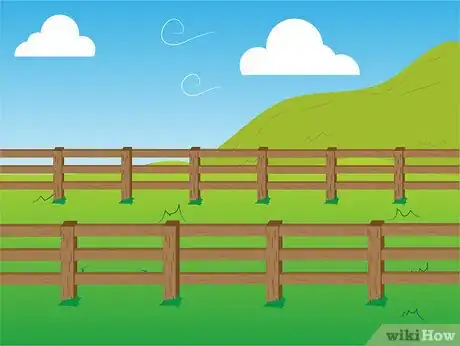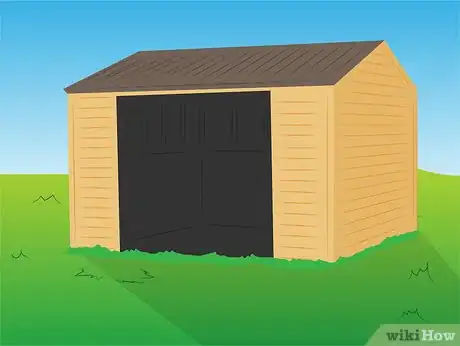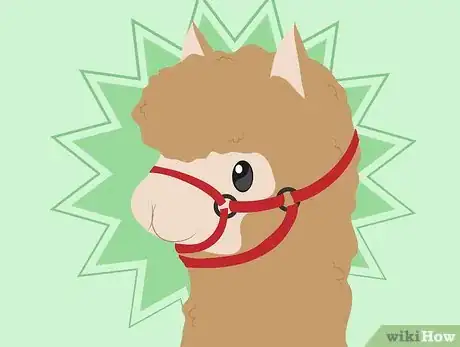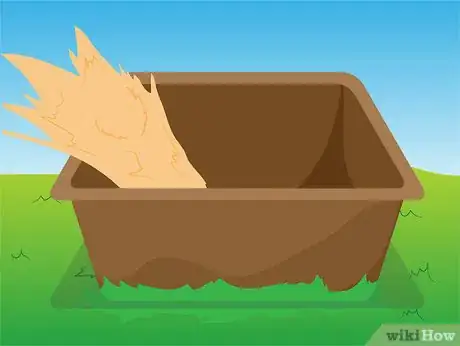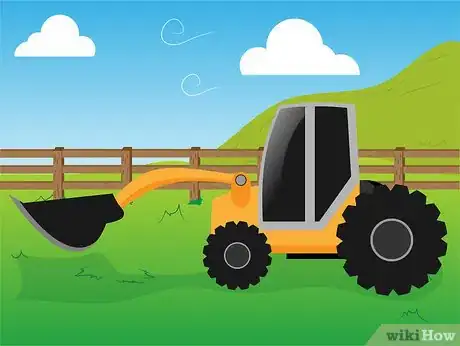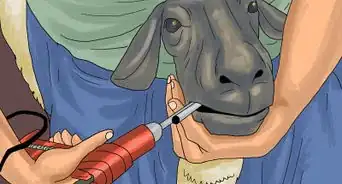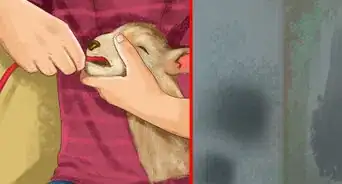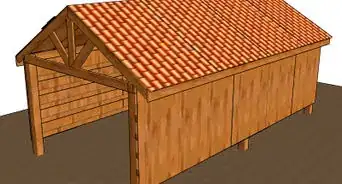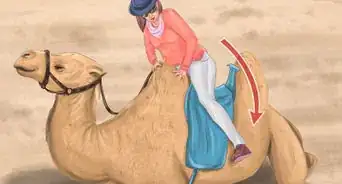X
wikiHow is a “wiki,” similar to Wikipedia, which means that many of our articles are co-written by multiple authors. To create this article, 22 people, some anonymous, worked to edit and improve it over time.
wikiHow marks an article as reader-approved once it receives enough positive feedback. In this case, 90% of readers who voted found the article helpful, earning it our reader-approved status.
This article has been viewed 73,508 times.
Learn more...
Are you interested in buying an alpaca? Here are some helpful tips on what to look for and where to find them!
Steps
Part 1
Part 1 of 3:
Before Searching for an Alpaca
-
1Decide what you will be using your alpacas for. Some ideas are:[1]
- Breeding
- Fiber (sales of raw or skirted fleeces)
- Natural fiber products.The creation and sale of end-use products (scarves, mittens, blankets, pillows, in-soles, yarns, rugs, weed-block, fiber arts)
- Therapy
- Education (including 4H for kids)
- Supplying top quality fertilizer to greenhouses
-
2If you plan on breeding, decide what you want the outcome to be and whether you want to breed right away or wait until you are a bit more established and comfortable with alpacas.
- If you want to get a head start, purchase females that are pregnant.
- If you plan on generating revenue put together a realistic business plan with the help of existing breeders who have a history of generating revenue in your areas of interest.
- If you plan on establishing a breeding farm, purchase young females and a herdsire (stud male alpaca), and perhaps a gelding (castrated male) to keep the stud company and later to babysit the weaning cria (alpaca offspring). You could also wait to buy a herd sire until you are ready for breeding.
- If you plan on breeding to obtain offspring to sell educate yourself on the value of the different genetic and fiber qualities. Then purchase starter animals that are capable of providing that quality.
Advertisement -
3Make sure you have enough fenced-in land for your alpaca. Your local environment and soil quality will determine how many animals your land will support. A good comparison is that about 8 alpacas will equal a horse or cow as far as grazing pressure goes. Check with your local Agricultural Outreach resources.
- The fence needs to be strong, at least four and a half to five feet tall, and the openings should be no more than four inches apart, otherwise, the alpaca could possibly break the fence, jump over it, get their head stuck or squeeze through to the other side. An even bigger reason to make sure your fences are secure and of proper materials is because dogs are a primary danger to alpacas. Coyotes are not such a problem as woven/fabric fences do a lot to deter them. Alpacas don't generally want to escape from the security of their herd and farm, but while roaming, stray dogs form packs and have been known to get into alpaca yards and attack, even kill, entire herds of alpacas not adequately fenced and guarded. Alpacas do not make good guard animals to protect other livestock.[2]
-
4Sow the land with hay, grass, etc. or buy your hay pre-cut. You will also need to add to your alpaca's diet: If you are breeding alpacas the quality of your feed can have a big impact on the outcome and quality produced.
- Vitamin supplements
- Natural hay. The quality and usefulness depends on the type of grass, when it was cut and how well it was put up. Hay from the same field cut at different times will produce different quality. Cured hay is easy to get tested and may be a good idea to utilize if you are new to feeding livestock. Be sure to avoid feeding fruits or vegetables too high in naturally occurring sugars and starches. Many ornamental plants found in residential landscaping are poisonous to livestock. Alpacas are very susceptible to the meningeal worm parasite.[3] Check with a local veterinarian for the recommended treatment protocol.
-
5Figure out how your alpaca is going to get water:
- An alpaca can live for days without food but in hot weather an alpaca may not survive one day without water. An automatic waterer with a heating element to prevent freezing is the most ideal way to make sure your animals are getting enough of good, clean water year round.[4] 5 gal or larger buckets also work but are much more labor intensive to maintain. A natural source can work but likely to contain serious parasites (Giardia E. Coli, Clostridium etc) etc. Keep their water source off the ground as they like to dip their feet in water. Water that they dip their feet in will be a source of parasites and illness. Same goes for natural and man made streams.
- Man-made streams. They also like to wade into water to cool off. This will affect the quality of their fleece and be a source of wool rot and other skin issues.
- A "self-watered" trough. Though these do not cost as much as a man-made stream, they are still pricey. But they are hooked up to a hose and set on a float or timer to fill the trough or bowls are convenient.
- A regular water trough. This is the cheapest, but you will have to fill it up at least twice a day with a hose or bucket yourself, depending on how many alpacas are drinking out of it.
-
6Set up some form of shelter for your alpaca. It needs to have adequate protection from the severe elements and be capable of keeping your alpaca warm and dry in the winter and cool in the summer. A three-sided shelter facing east or south works well, or a barn where the alpacas have free-choice to go in or stay out in adjoining paddocks. Keep in mind that a three sided shelter doesn't help if the storm comes in on the open side. If you are breeding and having crias you will likely need protection from all four sides. Figure at about 8 sq ft per alpaca in a shelter with at least 8 feet (2.4 m) of headroom. Lower ceiling will require less density.
Advertisement
Part 2
Part 2 of 3:
Purchase the Equipment
-
1Unless you plan on fighting your alpaca every time you need to take it someplace, like the vet, you need to purchase a good halter and know how to properly fit it on your alpaca. If your alpaca is not broken into a halter, you will either have to train it yourself or hire a trainer to do it for you. An alpaca halter should fit snugly, with the nose band high on the bridge near the alpaca's eyes, not low or loose, as is the case with horses or cows in halter.
-
2Get a sturdy feeding trough/container. When not out at pasture, cured grass hay is the most recommended source of feed for alpacas. This is referred to as "dry lot" feeding. For dry lot care, it is best to feed in some kind of feeder. Feeding directly on the ground will promote intestinal parasites.
- Contrary to popular belief, alpacas do not digest grains properly, leading to ulcers and possibly even death. Nutritional supplements (grain and forage mixtures) are very useful in a breeding program. Different blends are made to facilitate growth, lactation, and fiber nutrients. Free choice minerals should also be avail to help complement the nutrients that are lacking in your soil.
- Alpacas will develop a pecking order so having enough feeding stations will assure everyone has free access to eat. Some will share feeders other will not. Plan on about 3 lbs of dry grass hay per adult alpaca. (about 2% of body weight) Having separate feeding stations will keep them from feeling over-crowded and as if their food supply is threatened by the presence of the other alpacas in its group. Further, alpacas are smart, and can tip a regular feeding trough/container over easily.
- Another idea that works well is the installation of 8' or 10' vinyl gutters affixed to the fences, gates and/or sides of your buildings such that you can grain them with only one layer of grain or pellets, reducing the chance for the animals to gobble up too much food too quickly and choke. Shallow, sturdy rubber feeding bowls work well, too.
-
3Consider what tools you'll need.
- You might find it helpful to have a farm utility vehicle and/or small to mid-sized, reliable farm tractor with a loader or skid-steer.
- Get a garden tractor and/or brush hog for mowing around the farm but also in your alpacas' grazing fields.
- You will need a set of "paca-poop-pick-up" tools, such as rakes, shovels and scoopers, along with a cart or wheelbarrow or two to haul the muck away to the compost heap with.
-
4Be prepared for emergencies. An alpaca First Aid Kit is a must for routine care but also in case of emergencies. Ask your vet what you should put in this but here are a few ideas:
- Large bandages
- Splints
- Aspirator Bulb
- Bottle of Saline Solution
- Natural Tears
- Tube of Terramycin ointment (for the eyes)
- Alcohol for sterilization
- First-Aid Gauze and Tape, Pads and Cotton
- A chute, tie-down system or other alpaca-specific device designed for restraining your alpaca, if necessary
- A thermometer
- A stethoscope
- Vaseline or other lubricant
- Sterile gloves (latex or other synthetic)
- Probiotics or all natural, plain yogurt
- A llama tape or scale to track the animals' weights and body condition
- Novalsan or Betadine
- Corid (for treatment of coccidia when it arises)
- Ivomec, Ivermectin or other similar worming treatment/medication
- Safeguard liquid or paste (or Panacur, some brand of Fenbendazole)
- Vitamin B Complex
- L.A. 200 broad spectrum antibiotic (found in most farm supply stores)
Advertisement
Part 3
Part 3 of 3:
Locate Your Alpaca
-
1Be ready to spend a little money. Alpacas are not all created equally. A quality alpaca is rarely cheap, but you don't have to buy a million dollar show breeder.
-
2Here are some places that you can look:
- Alpaca breeders or farms
- Online sites and ads
- Newspaper ads
- Llama breeders or farms. Often times they will know places where you can get alpacas.
- A reputable alpaca agent or broker. There are only a couple of true, full-time professionals specializing in this service in the alpaca industry, and they are real advocates for buyers while providing a valuable service to the seller/owners. The best brokers are experienced alpaca farmers that are also well connected to breeders all over the United States. They can help you find the animals with the genes that will get you closer to your goals a whole lot faster than you might otherwise. Working with one will save you a lot of time and money in the long run because they are usually selling other people's animals and want to see you get what's best for you, not just an alpaca off their farm because it's theirs and they want to sell it and make all the money.
Advertisement
Community Q&A
-
QuestionI want to get two of them as pets, not for showing or breeding. Do I need permission from the township?
 Community AnswerMost likely no, but it depends on the town/state you live in. In my area it is a no, and most places it is a no but double check. Try calling city hall or your local animal shelter, they might know about legislation in place concerning animals.
Community AnswerMost likely no, but it depends on the town/state you live in. In my area it is a no, and most places it is a no but double check. Try calling city hall or your local animal shelter, they might know about legislation in place concerning animals. -
QuestionCan I put my two donkeys in with the alpacas for protection?
 Community AnswerYes, that sounds like a lovely idea for them! It would save money and time, too!
Community AnswerYes, that sounds like a lovely idea for them! It would save money and time, too! -
QuestionWhat is the average cost of an alpaca?
 Community AnswerIt varies; the prices can range from a few hundred dollars to tens of thousands of dollars depending on where you get your alpaca.
Community AnswerIt varies; the prices can range from a few hundred dollars to tens of thousands of dollars depending on where you get your alpaca.
Advertisement
Warnings
- Don't let the llama breeders talk you into getting a llama, if you want an alpaca.⧼thumbs_response⧽
- Alpacas do spit, contrary to some misconceptions. Their spit is normally green and gross, so be prepared.⧼thumbs_response⧽
Advertisement
Things You'll Need
- One acre per five to ten alpacas
- A halter
- Food and water troughs
- Hay, grass, grain, and other alpaca food
- A shelter for your alpaca
References
About This Article
Advertisement


